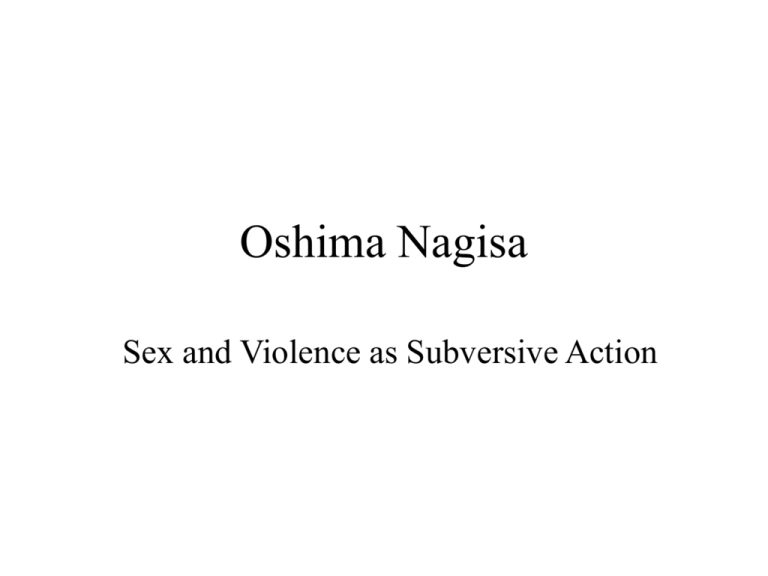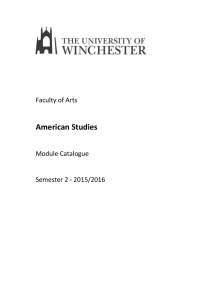
Oshima Nagisa
Sex and Violence as Subversive Action
The Post-war Japanese Film Industry
• Founded in 1912
• One of the oldest production companies. After
the dormant period, it resumed production in
1954; it recruited directors from other studios Imamura Shohei and Suzuki Seijun.
A successful genre, Nikkatsu Action Eiga - action
movies for the male audience. After the popularity
of cinema declined in the 60s, it successfully turned
to the production of soft-porn films, Nikkatsu
Roman Porno, with relatively high-budget and
production values.
The Post-war Japanese Film Industry
• Founded in 1920
• One of the most successful and reliable
companies through the 30s, 40s and 50s
- Studios in Kyoto specialized in producing
jidai geki
- Studios in Tokyo (Kamata and Ofuna)
specialized in producing gendai geki
Director’s studio - employed a large number of
established and talented directors under contract.
Conservative production policy and targeted
mainly the female audience.
The decline of its fortune from the late 50s as its
movies increasingly looked out of touch with the
rapidly changing Japanese society.
The Post-war Japanese Film Industry
• From 1945 to 2002
Under the charismatic president of the company
and chief executive producer, Nagata Masaichi, it
produced internationally acclaimed films Rashomon (1951), The Tale of Ugetsu (1953) and
The Gate of Hell (1954).
From the 50s to 60s it produced high-budget epics
using top film stars such as Machiko Kyo,
Yamamoto Fujiko, Wakao Ayako, and Ichikawa
Raizo. Autocratic Nagata became the cause of
trouble rather than asset in the 60s. Sensationalist
movies in the 60s.
The Post-war Japanese Film Industry
The film production branch of Takarazuka Theatre
Company founded by Kobayashi Ichiro, a showbusiness entrepreneur, in 1937.
After the war, the company experienced the
greatest labour dispute and was split into two
companies - Toho and Shin (new) Toho.
Kurosawa was under contract in the 50s.
Monster films such as Mothra and Godzilla were
its hit products of the 50s. During the slump it
shifted to the production of movies for children.
Now the most successful company turning popular
TV programmes and comics into films.
The Post-war Japanese Film Industry
• The youngest major film company founded by
the millionaire owner of Tokyu Railway Co.
Goto Keita in 1949, and later came to specialize
in genre pictures - crime thrillers, sward play
films, and Yakuza movies.
Commercially the most successful and the only film
company making healthy profits through Yakuza
films through the 60s and 70s while other film
companies were struggling to survive.
It came to also specialize in animation from the 80s
New Youth Films
• The emergence of a new genre in the mid-fifties youth film
• Its origin - the success of a novel - Season of the
Sun by Ishihara Shintaro
- a bestseller which scandalized the older generations and
created a social phenomenon, Taiyo-zoku (‘Sun-tribe’)
lifestyle and a series of ‘Taiyo-zoku’ movies
• Taiyo-zoku Japanese equivalence to Greasers
youth sub-cultural movements in US and Rockers
and Mods in Great Britain
Youth
subcultures in
the 50s and 60s
consumerism,
care-free and
reckless action,
loose sex, drug,
rock music
New Youth Films
• Phenomenal success of Nicholas Ray’s Rebel
without a Cause (1955) and Richard Brooks’
Blackboard Jungle - featuring the youth and
youth culture with sympathy
New Youth Films
• British films which dealt with the youth and new
youth culture in northern industrial cities: Karel
Reisz’s Saturday Night and Sunday Morning
(1960), Tony Richardson’s The Loneliness of the
Long Distant Runner (1962)
New Youth Films
Taiyo-zoku movies and the
new youth film
- about the youth who live
amoral, licentious and
irresponsible lives
• Season of the Sun (1956)
• Crazed Fruit (1956)
• Punishment Room (1956)
• Man Who Caused a Storm
(1957)
The genre was first exploited
by Nikkatsu
Created the new
young idols Ishihara Yujiro,,
Shishido Joe,
Akagi Keiichiro,
Kobayashi Akira
Nitani Hideaki, Watari
Tetsuya, Matsubara
Keiko, Asaoka Ruriko.
Thanks to the new
strategy, movie
attendance rose to just
over a billion, a post-war
high in 1958.
New Youth Films
• In 1958 Shochiku was the poor fourth after
Nikkatsu, Toho and Toei at the box office
• Rivals’ triumph, poor performances of its
films (including Ozu’s) and the success of
French nouvelle vague films prompted:
Change of its production policy (shift to the
movies targeted for the youth market) and
promotion of young assistants to directors.
Oshima Nagisa in Shochiku
• Entered Shochiku as
assistant director in
1954.
• With his friends he
started a film
magazine and wrote
scripts which were
never filmed.
• Political and artistic
radical.
Oshima Nagisa in Shochiku
• An admirer of Crazed Fruit by Nakahara Ko
• ‘Some people realized coming of new age for
Japanese movie within the sound of the woman’s
skirt torn and the swelling noise of the
motorboat on which the hero killed his brother.’
Oshima Nagisa in Shochiku
• Suddenly and unexpectedly he was given a
chance by Kido Shiro to direct a film.
• A Town of Love and Hope (1959, the original
title; The Boy Who Sold His Pigeon)
Oshima Nagisa in Shochiku
• Cruel Story of Youth (1960)
• A college student rescues a high school girl who
are being sexually assaulted. Their affair is not a
innocent one. They learn they can make easy
money by extorting money from men who make
a pass at her.
Oshima Nagisa in Shochiku
• The film is an examination of hopelessness,
victimization, apathy, exploitation, and cultural
alienation against the background of radical
political and social change - the student uprising
in Korea and movement against the US-Japan
Security Pact.
Oshima Nagisa in Shochiku
• The Sun’s Burial (1960): The underclass in
Osaka’s slum engage in pilfering, assaulting,
robbing, trading ID and blood.
• Portrayal of Japan’s lost generation; the
examination of the loss of Japanese cultural and
spiritual identity and its subsequent chaos and
nihilism.
Oshima Nagisa in Shochiku
Night and Fog in Japan (1960)
• A group of young intellectuals and their
professor gather for a wedding in which the
betrayal of the leftwing political activists is
revealed.
• Shochiku withdrew the film two days after its
opening.
Oshima Nagisa after Shochiku
• Oshima left Shochiku in
protest and became an
independent filmmaker.
His films were often
financed by ATG (Art
Theatre Guild), which
started as a distributor and
exhibitor (‘art theatre’) but
later produced films of
such directors as Oshima,
Imamura, Shinoda,
Yoshida.
Oshima Nagisa after Shochiku
• Violence at Noon (1966): A wealthy housewife is
raped and murdered by a drifter whom her
maidservant knows. The complicated relationship
between the murderer, his wife and the maid is
revealed through flashbacks.
• The portrayal of sexual desire, repression, and guilt.
Oshima Nagisa after Shochiku
Death by Hanging (1968)
• A Korean rapist and
murder is sentenced to
death by hanging, but he
survives the execution.
For the following two
hours, his executioners try
to work out how to handle
the situation in this black
farce.
Oshima Nagisa after Shochiku
• Film is a tragi-comic
and surrealistic
reflection of the
assimilation of
Japanese-Korean,
intolerance, and
capital punishment.
Oshima Nagisa after Shochiku
• Boy
• A man and a woman
travelled around Japan
with their young son,
whom they had trained to
run in front of moving cars
and pretend to be struck
and badly injured. The
parents would then demand
money from the frightened
drivers.
Oshima Nagisa after Shochiku
• The Ceremony (1971)
• A marriage is arranged between the two who had never met
before but it is about to be cancelled once the bride-to-be
sends words that she will not be arriving. The patriarch
insists the ceremony continue as planned. Bride or no bride,
the forms of tradition must be obeyed, so the gathered
guests watch as the humiliated Masuo stands at the altar
alone, “marrying” nothing but air.
Oshima Nagisa after Shochiku
• In the Realm of Senses (1978)
• A former prostitute now working in an inn is seduced by
its owner. A great passion sparks in both and they leave
the inn travelling around the country. They keep to
themselves giving their entire existences to sex. In the
end, with the man’s consent, the woman strangles him to
death in a sex ritual and cuts his penis.
Oshima Nagisa after Shochiku
• Empire of Passion (1978) a labourer in a provincial
village, falls in love with the
wife of a rickshaw driver.
The labourer and his lover
kill her husband to prevent
him from discovering their
affair, but when the driver’s
ghost begins to haunt Seki,
the lovers slowly fall apart.
Oshima Nagisa after Shochiku
• Merry Christmas, Mr.
Lawrence (1983) - set in
a POW camp in Java, a
British officer exerts a
strong sexual pull on the
Japanese captain, who
runs the camp. The
British officer must be
destroyed.
Oshima Nagisa after Shochiku
• Taboo (1999)
• Shinsengumi employs a young samurai, who has
feminine beauty. He becomes the centre of
homosocial and homosexual desire among the
members of the militia.
Oshima’s Themes and Subjects
• At the first glance, his subjects
and themes are eclectic.
• ‘Active subject’ = the director
expresses his deepest passions,
anxieties, and obsessions
• ‘Active subjects’ repeatedly
appear in Oshima’s films are:
• Exposé of social hypocrisy and
corruption; the abuse of power
and social and political
exploitation
Oshima’s Themes and Subjects
• Through examining criminal actions and sexual
behaviours, Oshima (1) flaunts the vulgarity of
characters, but at the same time, (2) reveals the
hypocrisy and corruption of the seemingly
prosperous and polite nation, which has created
them and makes them exist . Then, he
demonstrates (3) sexual crime and violence are
not without connection with social exploitation,
alienation and repression.







